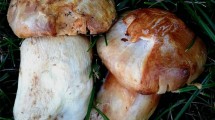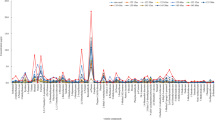Abstract
Within the pattern of volatiles released by food products (volatilome), potent odorants are bio-active compounds that trigger aroma perception by activating a complex array of odor receptors (ORs) in the regio olfactoria. Their informative role is fundamental to select optimal post-harvest and storage conditions and preserve food sensory quality. This study addresses the volatile metabolome from high-quality hazelnuts (Corylus avellana L.) from the Ordu region (Turkey) and Tonda Romana from Italy, and investigates its evolution throughout the production chain (post-harvest, industrial storage, roasting) to find functional correlations between technological strategies and product quality. The volatile metabolome is analyzed by headspace solid-phase microextration combined with comprehensive two-dimensional gas chromatography and mass spectrometry. Dedicated pattern recognition, based on 2D data (targeted fingerprinting), is used to mine analytical outputs, while principal component analysis (PCA), Fisher ratio, hierarchical clustering, and analysis of variance are used to find decision makers among the most informative chemicals. Low-temperature drying (18–20 °C) has a decisive effect on quality; it correlates negatively with bacteria and mold metabolic activity, nut viability, and lipid oxidation products (2-methyl-1-propanol, 3-methyl-1-butanol, 2-ethyl-1-hexanol, 2-octanol, 1-octen-3-ol, hexanal, octanal and (E)-2-heptanal). Protective atmosphere storage (99% N2–1% O2) effectively limits lipid oxidation for 9–12 months after nut harvest. The combination of optimal drying and storage preserves the aroma potential; after roasting at different shelf-lives, key odorants responsible for malty and buttery (2- and 3-methylbutanal, 2,3-butanedione and 2,3-pentanedione), earthy (methylpyrazine, 2-ethyl-5-methyl pyrazine and 3-ethyl-2,5-dimethyl pyrazine) and caramel-like and musty notes (2,5-dimethyl-4-hydroxy-3(2H)-furanone - furaneol and acetyl pyrrole) show no significant variation.

Comprehensive two-dimensional gas chromatography (GC × GC) coupled with mass spectrometric detection captures hazelnut volatiles signatures while advanced fingerprinting approaches based on pattern recognition enable access to a higher level of information





Similar content being viewed by others
References
Peterson RT. Chemical biology and the limits of reductionism. Nat Chem Biol. 2008;4:635–8.
Herrero M, Simò C, Garcia-Canas V, Ibanez E, Cifuentes A. Foodomics: MS-based strategies in modern food science and nutrition. Mass Spectrom Rev. 2012;31:49–69.
Dunkel A, Steinhaus M, Kotthoff M, Nowak B, Krautwurst D, Schieberle P, et al. Nature’s chemical signatures in human olfaction: a foodborne perspective for future biotechnology. Angew Chemie - Int Ed. 2014;53:7124–43. https://doi.org/10.1002/anie.201309508.
Firestein S. How the olfactory system makes sense of scents. Nature. 2001;413:211–8. https://doi.org/10.1038/35093026.
Spehr M, Munger SD. Olfactory receptors: G protein-coupled receptors and beyond. J Neurochem. 2009;109:1570–83. https://doi.org/10.1111/j.1471-4159.2009.06085.x.
Kinlin TE, Muralidhara R, Pittet AO, Sanderson A, Walradt JP. Volatile components of roasted filberts. J Agric Food Chem. 1972;20:1021–8.
Kiefl J (2013) Differentiation of hazelnut cultivars (Corylus avellana L.) by metabolomics and sensomics approaches using comprehensive two-dimensional gas chromatography time-of-flight mass spectrometry (GCxGC-TOFMS).
Baker M. Metabolomics: from small molecules to big ideas. Nat Meth. 2011;8:117–21.
Sheldon RM, Lindsay RC, Libbey LM. Identification of volatile flavor compounds from roasted filberts. J Food Sci. 1972;37:313–6.
Kiefl J, Pollner G, Schieberle P. Supporting information sensomics analysis of key hazelnut odorants (Corylus avellana L., “ Tonda Gentile ”) using comprehensive two-dimensional gas chromatography in combination with time-of-flight-mass spectrometry (GC × GC/TOF-MS ). J Agric Food Chem. 2013;4:1–20.
Burdack-Freitag A, Schieberle P. Changes in the key odorants of Italian hazelnuts (Coryllus avellana L. Var. Tonda Romana) induced by roasting. J Agric Food Chem. 2010;58:6351–9. https://doi.org/10.1021/jf100692k.
Seyhan F, Ozay G, Saklar S, Ertaş E, Satir G, Alasalvar C. Chemical changes of three native Turkish hazelnut varieties (Corylus avellana L.) during fruit development. Food Chem. 2007;105:590–6. https://doi.org/10.1016/j.foodchem.2007.04.016.
Alasalvar C, Pelvan E, Bahar B, Korel F, Ölmez H. Flavour of natural and roasted Turkish hazelnut varieties (Corylus avellana L.) by descriptive sensory analysis, electronic nose and chemometrics. Int J Food Sci Technol. 2012;47:122–31. https://doi.org/10.1111/j.1365-2621.2011.02817.x.
Schäfer H, Schulte E, Thier H. A novel and simple approach for assessing the freshness of hazelnuts. Eur Food Res Technol. 2002;215:249–54. https://doi.org/10.1007/s00217-002-0556-4.
Alasalvar C, Shahidi F, Cadwallader KR (2003) Comparison of natural and roasted Turkish tombul hazelnut (Corylus avellana L.) volatiles and flavor by DHA/GC/MS and descriptive sensory analysis comparison of natural and roasted Turkish tombul hazelnut (Corylus avellana L.) volatiles and flavor. Star. https://doi.org/10.1021/jf0300846.
Kiefl J, Pollner G, Schieberle P. Sensomics analysis of key hazelnut odorants (Corylus avellana L. “Tonda Gentile”) using comprehensive two-dimensional gas chromatography in combination with time-of-flight mass spectrometry (GC×GC-TOF-MS). J Agric Food Chem. 2013;61:5226–35. https://doi.org/10.1021/jf400807w.
Chin ST, Eyres GT, Marriott PJ. Cumulative solid phase microextraction sampling for gas chromatography-olfactometry of Shiraz wine. J Chromatogr A. 2012;1255:221–7. https://doi.org/10.1016/j.chroma.2012.03.084.
Marriott PJ, Chin ST, Maikhunthod B, Schmarr HG, Bieri S. Multidimensional gas chromatography. TrAC - Trends Anal Chem. 2012;34:1–20. https://doi.org/10.1016/j.trac.2011.10.013.
Marriott PJ, Eyres GT, Dufour JP. Emerging opportunities for flavor analysis through hyphenated gas chromatography. J Agric Food Chem. 2009;57:9962–71. https://doi.org/10.1021/jf9013845.
Cordero C, Kiefl J, Schieberle P, Reichenbach SE, Bicchi C. Comprehensive two-dimensional gas chromatography and food sensory properties: potential and challenges. Anal Bioanal Chem. 2015;407:169–91. https://doi.org/10.1007/s00216-014-8248-z.
Cordero C, Schmarr H-G, Reichenbach SE, Bicchi C. Current developments in analyzing food volatiles by multidimensional gas chromatographic techniques. J Agric Food Chem. 2017; https://doi.org/10.1021/acs.jafc.6b04997.
Nicolotti L, Cordero C, Bicchi C, Rubiolo P, Sgorbini B, Liberto E. Volatile profiling of high quality hazelnuts (Corylus avellana L.): chemical indices of roasting. Food Chem. 2013;138:1723–33. https://doi.org/10.1016/j.foodchem.2012.11.086.
Nicolotti L, Cordero C, Cagliero C, Liberto E, Sgorbini B, Rubiolo P, et al. Quantitative fingerprinting by headspace-two-dimensional comprehensive gas chromatography-mass spectrometry of solid matrices: some challenging aspects of the exhaustive assessment of food volatiles. Anal Chim Acta. 2013;798:115–25. https://doi.org/10.1016/j.aca.2013.08.052.
Wang Y, O’Reilly J, Chen Y, Pawliszyn J. Equilibrium in-fibre standardisation technique for solid-phase microextraction. J Chromatogr A. 2005;1072:13–7. https://doi.org/10.1016/j.chroma.2004.12.084.
Reichenbach SE, Carr PW, Stoll DR, Tao Q (2009) Smart templates for peak pattern matching with comprehensive two-dimensional liquid chromatography. 1216:3458–3466. https://doi.org/10.1016/j.chroma.2008.09.058.
Cordero C, Cagliero C, Liberto E, Nicolotti L, Rubiolo P, Sgorbini B, et al. High concentration capacity sample preparation techniques to improve the informative potential of two-dimensional comprehensive gas chromatography-mass spectrometry: application to sensomics. J Chromatogr A. 2013;1318:1–11. https://doi.org/10.1016/j.chroma.2013.09.065.
Kiefl J, Cordero C, Nicolotti L, Schieberle P, Reichenbach SE, Bicchi C. Performance evaluation of non-targeted peak-based cross-sample analysis for comprehensive two-dimensional gas chromatography-mass spectrometry data and application to processed hazelnut profiling. J Chromatogr A. 2012;1243:81–90. https://doi.org/10.1016/j.chroma.2012.04.048.
Cordero C, Liberto E, Bicchi C, Rubiolo P, Schieberle P, Reichenbach SE, et al. Profiling food volatiles by comprehensive two-dimensional gas chromatography coupled with mass spectrometry: advanced fingerprinting approaches for comparative analysis of the volatile fraction of roasted hazelnuts (Corylus avellana L.) from different ori. J Chromatogr A. 2010; 1217.
Adams RP. Identification of essential oil components by gas chromatography—mass spectroscopy. New York: Allured Publishing; 1995.
Poisson L, Schieberle L. Characterization of the key aroma compounds in an American bourbon whisky by quantitative measurements. Aroma recombination, and omission studies. J Agric Food Chem. 2008;56:5820–6.
Zhou K, Slavin M, Lutterodt H, Whent M, Yu L. Biochemistry of foods. Biochem Foods. 2013; https://doi.org/10.1016/B978-0-08-091809-9.00001-7.
NPCS board of consultants Engineers (2011) Handbook on fermented foods and chemicals. Handb Fermented Foods Chem 235–240.
Fridman E. Metabolic, genomic, and biochemical analyses of glandular trichomes from the wild tomato species Lycopersicon hirsutum identify a key enzyme in the biosynthesis of methylketones. Plant Cell Online. 2005;17:1252–67. https://doi.org/10.1105/tpc.104.029736.
Han BZ, Rombouts FM, Nout MJR. A Chinese fermented soybean food. Int J Food Microbiol. 2001;65:1–10. https://doi.org/10.1016/S0168-1605(00)00523-7.
Pastorelli S, Torri L, Rodriguez A, Valzacchi S, Limbo S, Simoneau C. Solid-phase micro-extraction (SPME-GC) and sensors as rapid methods for monitoring lipid oxidation in nuts. Food Addit Contam. 2007;24:1219–25. https://doi.org/10.1080/02652030701426987.
Ghirardello D, Contessa C, Valentini N, Zeppa G, Rolle L, Gerbi V, et al. Effect of storage conditions on chemical and physical characteristics of hazelnut (Corylus avellana L.). Postharvest Biol Technol. 2013;81:37–43. https://doi.org/10.1016/j.postharvbio.2013.02.014.
Hung R, Lee S, Bennett JW. The effects of low concentrations of the enantiomers of mushroom alcohol (1-octen-3-ol) on Arabidopsis thaliana. Mycology. 2014;5:73–80. https://doi.org/10.1080/21501203.2014.902401.
Goff SA, Klee HJ. Plant volatile Compounds: sensory cues for health and nutritional value? Science. 2006;311(5762):815–9.
Kiefl J, Schieberle P. Evaluation of process parameters governing the aroma generation in three hazelnut cultivars (Corylus avellana L.) by correlating quantitative key odorant profiling with sensory evaluation. J Agric Food Chem. 2013;61:5236–44. https://doi.org/10.1021/jf4008086.
Cordero C, Bicchi C, Rubiolo P. Group-type and fingerprint analysis of roasted food matrices (coffee and hazelnut samples) by comprehensive two-dimensional gas chromatography. J Agric Food Chem. 2008;56:7655–66. https://doi.org/10.1021/jf801001z.
Burdack-freitag A, Schieberle P. Characterization of the key odorants in raw Italian hazelnuts. J Agric Food Chem. 2012;60:5057–64.
Saklar S, Katnas S, Ungan S. Determination of optimum hazelnut roasting conditions. Int J Food Sci Technol. 2001;36:271–81. https://doi.org/10.1046/j.1365-2621.2001.00457.x.
Jelen H (2012) Food flavors: chemical, sensory and technological properties. https://doi.org/10.1201/b11187-1.
Reichenbach SE, Tian X, Cordero C, Tao Q. Features for non-targeted cross-sample analysis with comprehensive two-dimensional chromatography. J Chromatogr A. 2012;1226:140–8. https://doi.org/10.1016/j.chroma.2011.07.046.
Acknowledgements
The research was carried out thanks to the financial support of Soremartec Italia srl, Alba (Cuneo) Italy.
Author information
Authors and Affiliations
Corresponding author
Ethics declarations
Notes: Nicola Spigolon, Marco Somenzi and Mauro Fontana are employees of Soremartec Italia srl, Alba (Cuneo) Italy.
Additional information
Published in the topical collection Discovery of Bioactive Compounds with guest editors Aldo Laganà, Anna Laura Capriotti and Chiara Cavaliere.
Electronic supplementary material
ESM 1
(PDF 587 kb)
Rights and permissions
About this article
Cite this article
Rosso, M.C., Liberto, E., Spigolon, N. et al. Evolution of potent odorants within the volatile metabolome of high-quality hazelnuts (Corylus avellana L.): evaluation by comprehensive two-dimensional gas chromatography coupled with mass spectrometry. Anal Bioanal Chem 410, 3491–3506 (2018). https://doi.org/10.1007/s00216-017-0832-6
Received:
Revised:
Accepted:
Published:
Issue Date:
DOI: https://doi.org/10.1007/s00216-017-0832-6




